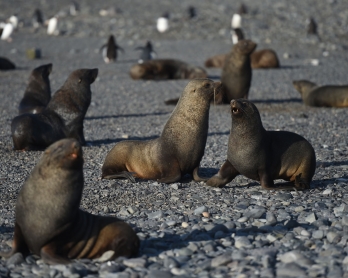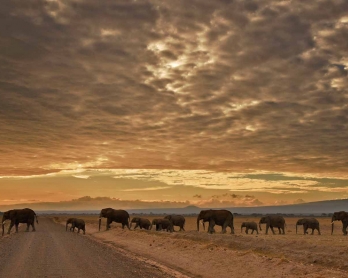Mesmerized by orcas in the north
Tromso, northern Norway -- When two of AFP’s most experienced photographers went to photograph orcas high above the Arctic Circle, they didn’t expect to fall in love. The setting wasn’t exactly welcoming -- air temperatures of minus 10-15 degrees Celsius, water temperatures barely above zero. On top of that, Mother Nature was not at all cooperative in Tromso, northern Norway. Not only did they have barely two hours of daylight in which to work every day, the skies were overcast and the normally clear waters of the fjords were murky because of all the sediment a storm had kicked up the week before.
But no matter -- after a week of diving with the graceful giants, Olivier Morin and Francois-Xavier Marit fell completely under their spell. “It was magical.”
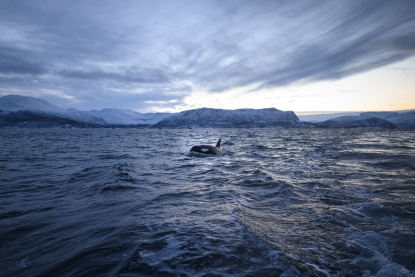 An orca swims in the Reisafjorden fjord, January, 2019.
(AFP / Olivier Morin)
An orca swims in the Reisafjorden fjord, January, 2019.
(AFP / Olivier Morin)
Francois-Xavier Marit
I never expected that I would enjoy myself so much on this trip. You can understand why -- I have never been diving in such cold water. So while the prospect of seeing orcas in the wild was of course exciting, the idea of doing so in freezing cold temperatures was not.
I am used to diving, but most of the time, it’s to install remote-control equipment in warm pools before international swimming competitions. Or diving in reasonable climates, like Spain or Greece. So I was anxious about how this trip was going to go.
My colleague Olivier is used to working in such frigid weather -- he loves the cold and thinks surfing in the winter above the Arctic Circle is fun. And even though he assured me it wouldn’t be that bad, I can’t say I was 100 percent reassured.
Throughout the week that we spent there, we were based on an old fishing boat, the Sula, where we lived as it roamed the fjords, searching for orcas.
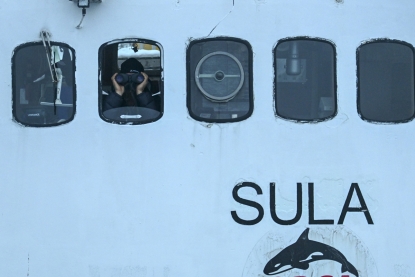 Captain Olav looks for orcas aboard the Sula in the Reisafjorden fjord region, January, 2019.
(AFP / Olivier Morin)
Captain Olav looks for orcas aboard the Sula in the Reisafjorden fjord region, January, 2019.
(AFP / Olivier Morin)Onboard were tourists and our guide, orca expert Pierre Robert de Latour, who has studied these animals for 20 years.
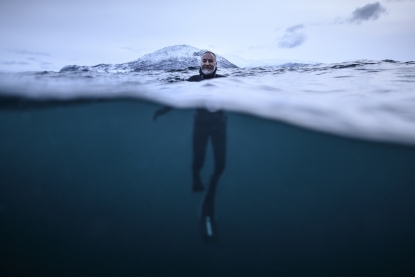 French orcas expert Pierre Robert De Latour poses for a photograph on January 17, 2019, in the waters of the Reisafjorden fjord region.
(AFP / Olivier Morin)
French orcas expert Pierre Robert De Latour poses for a photograph on January 17, 2019, in the waters of the Reisafjorden fjord region.
(AFP / Olivier Morin)When the crew would spot the animals, they’d give us the signal to change into our drysuits and would lower a dinghy into the water. We’d climb in and follow the animals, to get as close to them as possible.
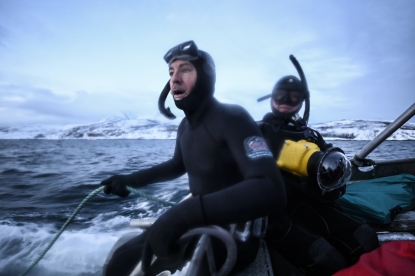 (AFP / Olivier Morin)
(AFP / Olivier Morin)I can’t say that the dinghy was a great experience for me. Since you’re going fast, it feels even colder than the minus 10-15 Celsius that it was outside. I sat there, clutching my equipment, shivering, and thinking about how to keep warm.
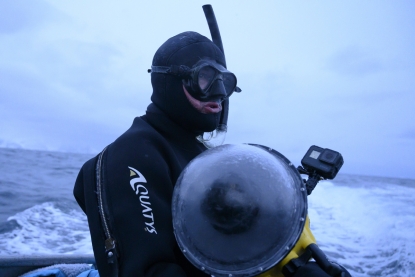 AFP photographer Olivier Morin tries to keep warm next to iced-over photo equipment as he rides in a dinghy to get closer to orcas, January, 2019. (AFP / Francois-Xavier Marit)
AFP photographer Olivier Morin tries to keep warm next to iced-over photo equipment as he rides in a dinghy to get closer to orcas, January, 2019. (AFP / Francois-Xavier Marit)When Pierre determined that the time was right to jump in, he’d give us the signal to do so. The first time that it happened, I didn’t have time to think, I just jumped. And there, I saw my first orca.
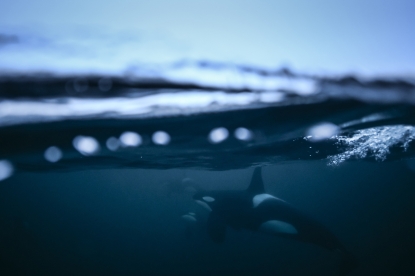 (AFP / Olivier Morin)
(AFP / Olivier Morin)We basically had two types of experiences. They would either interact with us, swimming around for a bit, or just look at us and then swim away, following the herring that is their main food source in these parts.
When you swim with the orcas, you don’t touch them. You’re their guest and you just stay and let them do whatever they want.
You hear their song and it’s magic. Even out of the water, you’d hear them.
There was one moment that stands out in my mind. The light was disappearing, so it was dusk. The lamp from the dinghy was reflecting in the water. You pulled yourself out of the water and you still heard the orcas. It was otherworldly. Magical.
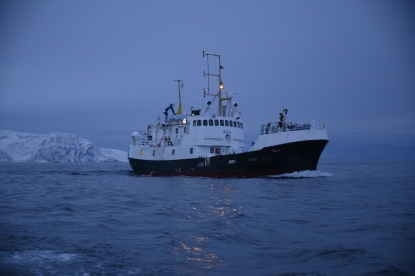 The Sula at dusk, January, 2019.
(AFP / Olivier Morin)
The Sula at dusk, January, 2019.
(AFP / Olivier Morin)The boat that was our home was named "Sula" and captained by Olav Stromsholm, who has been running tours like these for some 20 years.
When we weren’t in the water, there was a lot of waiting and talking. For seven days, you’re immersed in this ambience and the passion of these people, who live for these orcas and the enthusiasm of the tourists who had come to observe them.
And besides the passion for the surroundings, we had the extra bonus of the passion for the images. Our goal was to get photos and video of orcas that AFP clients could use and to test how equipment works in such conditions, in order to have better images the next time.
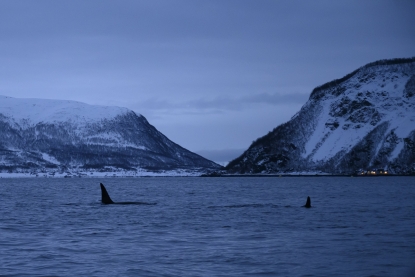 (AFP / Olivier Morin)
(AFP / Olivier Morin)So we weren’t just thinking of the magic all around us, we were always calculating how to translate that magic into images. Unfortunately we didn’t have the best conditions -- it was overcast above and the water was murky because of sediment kicked up by a storm the previous week. But on the other hand, this gave the pictures a dramatic effect and we got to see how the equipment performs in really low contrast situations. You make do with what you have.
And in the end, the cold that I was so worried about wasn’t that bad at all. That first dive, when I jumped in without thinking, turned out to be quite pleasant -- the water was warmer than the air, so it actually felt nice to go in.
It was only when I was climbing back into the dinghy after that first dive that I actually thought about it. That wasn’t that bad, I thought to myself. I can do this.
 Author Francois-Xavier Marit keeps warm. (AFP / Olivier Morin)
Author Francois-Xavier Marit keeps warm. (AFP / Olivier Morin)
Olivier Morin
I have been wanting to do this story for a while, as it combines several things that I’m passionate about -- the cold, extreme conditions, and climate change. But this exceeded all my expectations.
 (AFP / Olivier Morin)
(AFP / Olivier Morin)It was a few years back that I heard that the orcas have been moving more and more up north as their main food source in the area -- herring -- migrates up north in search of the cool water that they prefer. I have been wanting for a while to do more climate change stories, especially in extreme conditions and this seemed like a perfect fit -- and we’d get file pictures of orcas to boot.
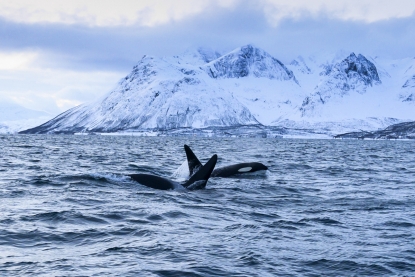 (AFP / Olivier Morin)
(AFP / Olivier Morin)I am an aficionado of cold weather. One of my favorite stories to shoot over the past few years has been of people surfing above the Arctic Circle in Norway. I have photographed a freediver plunging to the depths in the winter lakes of Finland. So diving in the north was right up my alley.
The animals have moved 200-300 kilometers more north in the past five years and some 600 kilometers more north in the past 20 years following the herring.
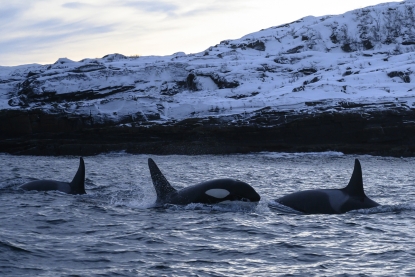 (AFP / Olivier Morin)
(AFP / Olivier Morin)We had a limited window during which we could photograph them. They follow the herring into the fjords between November and January, so we ended up going in January. We had about 2.5 hours of daylight, between 1130 and 1330. And daylight is a big word. The sun was low on the horizon and we didn’t luck out because it was overcast.
I would have preferred clear skies, of course. But on the other hand, the blue tint of twilight gave it a very dramatic atmosphere. It was otherworldly.
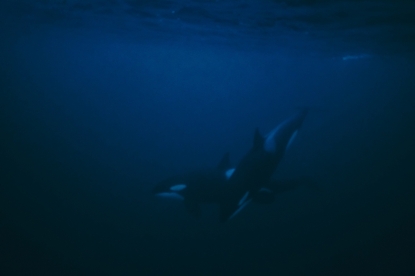
The air was -5 to -10 degrees Celsius and the water was 3 degrees, so you actually welcomed getting into the water because it felt warmer.
Pierre, the orca expert we went with, has been working with these animals for 20 years, so he knows his stuff. He has very specific tactics on how to approach them. You always come up on the side, never head on, you go at the same speed as them, so that they have the option of leaving if they want.
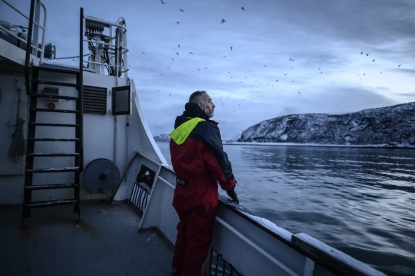 (AFP / Olivier Morin)
(AFP / Olivier Morin)Those animals are just magic. You feel right away that they’ve seen you. You get the feeling that you are not at all a problem for them. They float on their back and they just scan you. They have this calm look in their eyes, it’s like they’re telling you “I’ve seen you, it’s fine, I know you’re there. I’m not worried about you at all.”
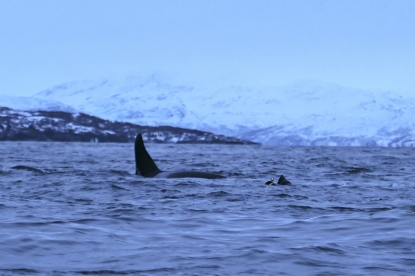 Author Olivier Morin (to the right) gets up close and personal with orcas in the fjords. (AFP / Francois-Xavier Marit)
Author Olivier Morin (to the right) gets up close and personal with orcas in the fjords. (AFP / Francois-Xavier Marit)Looking at them up close, you realize that they’re perfect machines. They’re perfectly built predators and they’re extremely intelligent. But scientists don’t know that much about them. And what is known so far is fascinating.
Pierre told us that there have been no instances of orcas attacking humans in the wild. They grieve for their dead. If one of them is injured, they help that orca eat. They not only communicate, but apparently different pods have different dialects, with their vocalizations as different from each other as human languages or dialects.
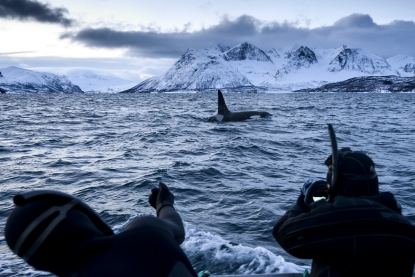
And they’re so elegant. These huge predators have this amazing grace to them. They can come as close as they want to you and you never even feel threatened. Not once during the entire week did I feel ill at ease when they were nearby.
They way they moved, it was a ballet. They have a special technique to eat herring. They herd them so the fish are close together and then smack them with their powerful tails, killing some and stunning others.
And then they feast. But they don’t just vacuum the herring up. They eat the fish one by one. And then spit out the head and bones. It’s just awesome to behold, these huge animals eating with such grace and manners. That’s class, was all that I could think looking at them. They eat 300-400 fish per day. So it’s really something that they take such care with each one.
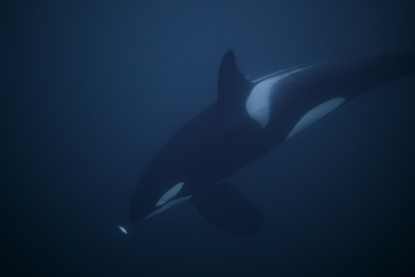
They’re such perfect machines and they’re very smart. They move with such grace and come close to you, as near as they want.
The whole experience was mesmerizing. Because you don’t just see their grace. You also hear their songs. Their beautiful, haunting songs. If I could have stayed for 10 hours watching them, I would have stayed for 10 hours. You just don’t want it to end. It’s like they hypnotize you.
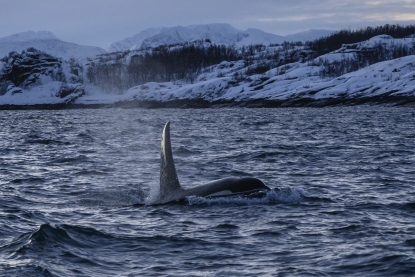 (AFP / Olivier Morin)
(AFP / Olivier Morin)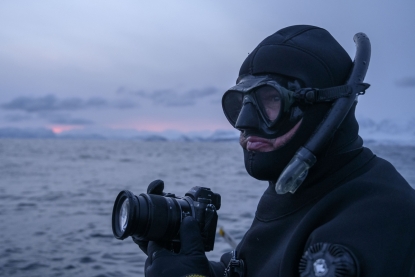 Author Olivier Morin mesmerized by the orcas he sees. (AFP / Francois-Xavier Marit)
Author Olivier Morin mesmerized by the orcas he sees. (AFP / Francois-Xavier Marit)
Conditions for photography weren’t ideal. I would have preferred clearer water -- usually in these waters you get 20-30 meters visibility, but we only had 10-15 meters because a storm the week before stirred things up. But I’ll get another chance because I’m definitely going to do this again.
I love surfing, but I have to admit that this experience was slightly beyond the wellness of surfing. It was more emotional. Surfing clears out your body and mind. This was more of a trance.
This blog was written with Yana Dlugy in Paris.





